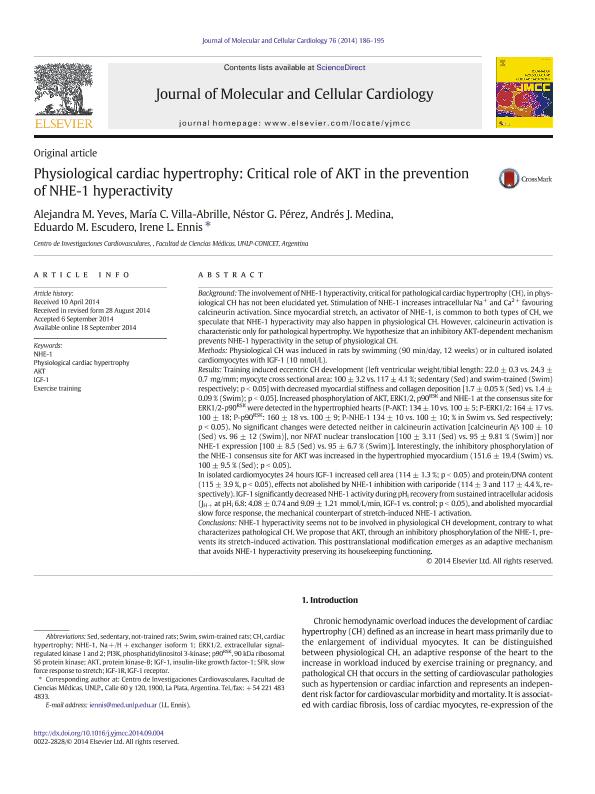Artículo
Physiological cardiac hypertrophy: Critical role of AKT in the prevention of NHE-1 hyperactivity
Yeves, Alejandra del Milagro ; Villa-Abrille, María Celeste
; Villa-Abrille, María Celeste ; Perez, Nestor Gustavo
; Perez, Nestor Gustavo ; Medina, Andrés Javier
; Medina, Andrés Javier ; Escudero, Eduardo M.; Ennis, Irene Lucia
; Escudero, Eduardo M.; Ennis, Irene Lucia
 ; Villa-Abrille, María Celeste
; Villa-Abrille, María Celeste ; Perez, Nestor Gustavo
; Perez, Nestor Gustavo ; Medina, Andrés Javier
; Medina, Andrés Javier ; Escudero, Eduardo M.; Ennis, Irene Lucia
; Escudero, Eduardo M.; Ennis, Irene Lucia
Fecha de publicación:
09/2014
Editorial:
Elsevier
Revista:
Journal of Molecular and Cellular Cardiology
ISSN:
0022-2828
Idioma:
Inglés
Tipo de recurso:
Artículo publicado
Clasificación temática:
Resumen
Background: The involvement of NHE-1 hyperactivity, critical for pathological cardiac hypertrophy (CH), in physiological CH has not been elucidated yet. Stimulation of NHE-1 increases intracellular Na+ and Ca2 + favouring calcineurin activation. Since myocardial stretch, an activator of NHE-1, is common to both types of CH, we speculate that NHE-1 hyperactivity may also happen in physiological CH. However, calcineurin activation is characteristic only for pathological hypertrophy. We hypothesize that an inhibitory AKT-dependent mechanism prevents NHE-1 hyperactivity in the setup of physiological CH. Methods: Physiological CH was induced in rats by swimming (90 min/day, 12 weeks) or in cultured isolated cardiomyocytes with IGF-1 (10 nmol/L). Results: Training induced eccentric CH development (left ventricular weight/tibial length: 22.0 ± 0.3 vs. 24.3 ± 0.7 mg/mm; myocyte cross sectional area: 100 ± 3.2 vs. 117 ± 4.1 %; sedentary (Sed) and swim-trained (Swim) respectively; p < 0.05] with decreased myocardial stiffness and collagen deposition [1.7 ± 0.05 % (Sed) vs. 1.4 ± 0.09 % (Swim); p < 0.05]. Increased phosphorylation of AKT, ERK1/2, p90RSK and NHE-1 at the consensus site for ERK1/2-p90RSK were detected in the hypertrophied hearts (P-AKT: 134 ± 10 vs. 100 ± 5; P-ERK1/2: 164 ± 17 vs. 100 ± 18; P-p90RSK: 160 ± 18 vs. 100 ± 9; P-NHE-1 134 ± 10 vs. 100 ± 10; % in Swim vs. Sed respectively; p < 0.05). No significant changes were detected neither in calcineurin activation [calcineurin Aβ 100 ± 10 (Sed) vs. 96 ± 12 (Swim)], nor NFAT nuclear translocation [100 ± 3.11 (Sed) vs. 95 ± 9.81 % (Swim)] nor NHE-1 expression [100 ± 8.5 (Sed) vs. 95 ± 6.7 % (Swim)]. Interestingly, the inhibitory phosphorylation of the NHE-1 consensus site for AKT was increased in the hypertrophied myocardium (151.6 ± 19.4 (Swim) vs. 100 ± 9.5 % (Sed); p < 0.05). In isolated cardiomyocytes 24 hours IGF-1 increased cell area (114 ± 1.3 %; p < 0.05) and protein/DNA content (115 ± 3.9 %, p < 0.05), effects not abolished by NHE-1 inhibition with cariporide (114 ± 3 and 117 ± 4.4 %, respectively). IGF-1 significantly decreased NHE-1 activity during pHi recovery from sustained intracellular acidosis (JH + at pHi 6.8: 4.08 ± 0.74 and 9.09 ± 1.21 mmol/L/min, IGF-1 vs. control; p < 0.05), and abolished myocardial slow force response, the mechanical counterpart of stretch-induced NHE-1 activation. Conclusions: NHE-1 hyperactivity seems not to be involved in physiological CH development, contrary to what characterizes pathological CH. We propose that AKT, through an inhibitory phosphorylation of the NHE-1, prevents its stretch-induced activation. This posttranslational modification emerges as an adaptive mechanism that avoids NHE-1 hyperactivity preserving its housekeeping functioning.
Palabras clave:
Nhe-1
,
Physiological Cardiac Hypertrophy
,
Akt
,
Igf-1
,
Exercise Training
Archivos asociados
Licencia
Identificadores
Colecciones
Articulos(CIC)
Articulos de CENTRO DE INVEST.CARDIOVASCULARES (I)
Articulos de CENTRO DE INVEST.CARDIOVASCULARES (I)
Citación
Yeves, Alejandra del Milagro; Villa-Abrille, María Celeste; Perez, Nestor Gustavo; Medina, Andrés Javier; Escudero, Eduardo M.; et al.; Physiological cardiac hypertrophy: Critical role of AKT in the prevention of NHE-1 hyperactivity; Elsevier; Journal of Molecular and Cellular Cardiology; 76; 9-2014; 186-195
Compartir
Altmétricas



